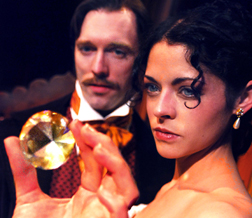From the Chicago Tribune
February 16, 2011
By Kerry Reid
An exotic gem from India sets off a string of misadventures and misunderstandings for a gaggle of handsome Brits. No, it’s not the Beatles in “Help!” — it’s Wilkie Collins’ classic 1868 Victorian detective tale, “The Moonstone,” now in a tidy world-premiere adaptation courtesy of Lifeline Theatre.
This is the second show in a row for the Rogers Park company set at least partly in the lonely wastelands of Yorkshire, but the tone of Robert Kauzlaric’s well-constructed script and Paul S. Holmquist’s staging couldn’t be further removed from the Gothic histrionics of the season opener, “Wuthering Heights.”
Collins’ epistolary novel allows Kauzlaric ample room for divvying up the narration and point of view between the various characters involved in the convoluted story of the sacred (and possibly cursed) yellow diamond acquired — and then lost — by the beautiful Rachel Verinder (Ann Sonneville). The effect is not so much “Rashomon” as it is a cross between “Masterpiece Theatre” and a relay race conducted at a brisk stroll — and I do mean that as a compliment. This isn’t a thrill-a-minute ride, but a cozy immersion in the tropes that would later dominate the world of mystery writers: strange visitors, double-dealing relatives and eccentric detectives (here embodied by David Skvarla’s rose-worshipping Sgt. Cuff).
From basset-eyed butler Gabriel Betteredge (a splendid Sean Sinitski), who gets caught up in “detective fever,” to proselytizing poor relation Drusilla Clack (Kaitlin Byrd), to Rachel’s tormented onetime paramour, Franklin Blake (Cody Proctor), suspected of stealing back the gem he presented to his lady love, the direct-address device handily gives us the exposition we need in digestible portions, and also creates a sly tug of war between the characters for the affections of the audience.
The story does require some close attention, particularly in the first act, which establishes the principals and their somewhat convoluted relationships. But very little drags. Ian Zywica’s spare bilevel Georgian set allows for fast scene changes and cleverly unpeels to reveal the dry rot under the placid surface of the upper-class world.
The 11 members of the ensemble, many of whom play multiple roles, handle the transitions with ease, and the doubling also allows for some touching resonances — most notably when Byrd moves from the insufferable Drusilla to lovelorn housemaid Rosanna. Kauzlaric’s script touches on the brutal consequences of colonialist imperialism and opium addiction without losing sight of the fact that “The Moonstone” should, above all, reflect a slightly askew, but affectionate, portrait of a comfortable English gentry on the verge of unimaginable changes.
From Windy City Times
February 23, 2011
By Mary Shen Barnidge
It’s a statement of fact, not idle nostalgia, to say that they don’t write stories like this any more. Wilkie Collins’ Victorian thriller shares credit with Poe’s Gold Bug as the prototype for the detective story genre, but whodunits in 1868 were expected to provide several weeks of ruminative reading, each new revelation being only a small step toward actually solving the crime. And so, given the length and intricacy of the source material, Rob Kauzlaric’s two-and-three-quarter-hour adaptation (with two intermissions) represents a model of verbal efficiency.
In the first 30 minutes we learn that a sacred diamond, stolen in India by a misanthropic colonialist, has brought misfortune and discord on his descendants, and that it is now in the possession of the lovely Miss Rachel Verinder, who wears it to a party attended by her two would-be suitors—the urbane philanthropist, Godfrey Ablewhite, and the long-estranged Franklin Blake. The jewel is stolen from her boudoir that very night, after some mysterious Hindu entertainers are sighted in the vicinity, whereupon a housemaid with a shady past begins to behave erratically, even as the burglary victim refuses to co-operate with the private investigator summoned to identify the culprit.
Our shamus has plenty of help. The compulsion to join in the search for the thief—what the family steward dubs, “detective fever”—is as universal as it is irresistible. The novel’s epistolary structure is rendered on the stage by a bevy of serial narrators, none of whom are above interrupting one another’s testimony to dispute order of disclosure or to hint at further information to come. Far from confusing playgoers likewise stricken with the sleuthing malady, this device serves to keep the raconteurs firmly on track as they guide us through a universe where substances frowned on today—e.g. opiates and tobacco—were commonplace.
This brand of boat-in-the-bottle drama is Lifeline’s stock-in-trade: Paul S. Holmquist’s direction makes for an always-uncluttered stage picture (as do the dressers responsible for converting the 11 actors into twice that number of characters in mere seconds). Together with Ian Zywica’s multiple-level scenic design—encompassing locales ranging from the exotic Orient to the foggy marshes of northern England—Cristina DeRisi’s cello-based score of somnolent incidental music, and Brandon Wardell’s shadowy lighting, they create an atmosphere of suspense to rivet our curiosity for every swiftly paced minute leading up to a satisfying resolution.
From Time Out Chicago
February 23, 2011
By Christopher Shea
FOUR STARS
Based on Collins’s 1868 detective novel, The Moonstone smacks a bit of Martin Scorsese’s Shutter Island, another unsettling mystery that strings you along for hours before coming to its rather underwhelming and nonsensical final reveal. But here, as in Marty’s work, you’d be hard-pressed to really mind. For it’s the stringing along itself — the shocking discoveries before sudden blackouts — that makes the piece such a blue-balling pleasure to watch.
The mystery in Moonstone begins when an aristocratic British uncle bequeaths his niece, Rachel, a Far Eastern moonstone, rumored by its Oriental keepers to have entrancing powers. The very night Rachel (a fetching Ann Sonneville) receives the stone, it disappears from her bedroom. But by whose hand, and why? Through the eyes of Rachel’s family servant, Gabriel (Sean Sinitski), we watch the mysteries accrue at her family’s country manor. The moonstone-hunt then relocates to London — and switches narratorial hands several more times — as death, financial intrigue, and threatening, balletic Hindus spring up around Rachel’s friends and family.
Kauzlaric uses the shifting narratorial device too cautiously, burdening potentially seamless action with explanations of who’ll say what, and why. But the slick production smooths over these edges. Bill Morey’s flamboyant period costumes (which mix shades to splashy effect) add a mesmerizing touch of chic to every scene. Brandon Wardell’s lights emphasize climactic moments with pleasurable ham-fistedness. Even Ian Zywica’s scenic design (which features an odd combination of amateurish paint jobs and multitiered, crafted cleverness) sets the right mood: self-serious, maybe, but fashioned to tell a ripping good tale.
From Chicago Stage Style
February 15, 2011
By Joe Stead
“You cannot escape the past” is a recurring theme laced throughout Lifeline Theatre’s latest World Premiere. The subject is “The Moonstone,” said to have been the first mystery novel published in the English language. Its author, Wilkie Collins, was a close friend and travel companion of Charles Dickens, although their literary journeys took them on vastly different social courses. Bringing words intended for the page to life on a stage is quite the challenge, and one in which the Lifeline company always gracefully excels. This is masterful storytelling in the best Lifeline classic literary tradition.
Robert Kauzlaric’s three-act adaptation of “The Moonstone” takes on an almost Rashomon-like investigation into the disappearance of a mystical jewel from different perspectives. The danger here is that the characters may spend too much time on narrative that makes for good reading but dull theatre. That is a trap that Kauzlaric and Director Paul S. Holmquist cleverly manage to avoid. They create such an intriguing and lively web of suspense that the nearly 3-hour production practically flies by. Each story teller is able to add an element of complexity that heightens the dramatic stakes and keeps the audience riveted throughout the journey.
The Moonstone of the title is an ancient jewel steeped in mysticism and Hindu mythology. For centuries the precious stone was set in the eye of an Indian statue and guarded by a succession of Hindu priests until it was seized during a renegade British invasion. The stone was stolen by an evil Colonel, who willed it to his beautiful young niece, Rachel Verinder. Did Rachel’s uncle also bestow a legacy of danger with the gift? The elusive diamond becomes the pawn in a scandal-prone family of aristocrats, misfits, scheming servants, and mercenary friends and relatives. They are all players, we are told, in a story rooted in myth. As one witness testifies, there may never be an objective truth available, so it is up to each person to share their fragment of the puzzle.
Director Holmquist and his large, beautifully appointed cast keep the pot boiling right up through the play’s briskly paced conclusion. Clear diction is helpful in making even the accelerated pace coherent. And just as the tale whittles one mystery away after another, so too do the walls of Scenic Designer Ian Zywica’s stately English manor come tumbling apart down to their studs. It’s a marvelous metaphor for getting to the bones of the truth. A mournful cello underscores Cristina DeRisi’s wonderfully moody sound design, while Costume Designer Bill Morey dresses the cast in an impressive array of period finery that allows the various character transformations to unfold effortlessly.
Author Wilkie Collins casts a believable spell of suspicion over each and every inhabitant of the story. The benefactor of the Moonstone, Rachel Verinder, is quite put off by the investigative intrusion into her private life, claiming “This is a vile farce and I want nothing to do with it”. That’s enough for the botanical loving Sergeant Richard Cuff to place her at the top of his list of possible culprits. Then there is the lovelorn chambermaid Rosanna Spearman, with a hidden past and unrequited love for Franklin Blake, whose own heart is already committed to Miss Verinder. Rachel’s philanthropic cousin Godfrey Ablewhite hopes to make their relationship a bit less platonic, but is he truly motivated by love or fortune?
Rachel’s spinster cousin Drusilla Clack is a religious crusader who hopes to make a few converts out of these miserable sinners for her Christian conversion club. A longtime house steward, Gabriel Betteredge, takes solace in the words of “Robinson Caruso,” which suggests that the fear of danger is far greater than danger itself. A trio of conjurers in Indian garb adds to that sense of danger, as each and every member of the cast is interrogated, and made to account for themselves. Through their assorted stories, Lifeline has uncovered a rare gem of a mystery that is beautifully set and minted.
From chicagocritic.com
Sprawling suspense mystery novel brilliantly comes to life on stage
February 15, 2011
By Tom Williams
Highly Recommended
The creatives at Lifeline Theatre are quite adapt at taking sprawling novels and turning them into terrific stage plays. They do that by keeping the essential style and scope of the novel intact. That is no easy task. Add to that, they pick marvelous works, many obscure yet containing grand theatrical themes and quirky memorable characters.
Smartly adapted by Robert Kauzlaric, The Moonstone contains Wilkie Collins’ style that includes the use of an omniscient narrator — several, in fact, that spice up the story with bits of humor and peculiar behavior. The Moonstone was serialized in 1868 in Charles Dickens’ magazine — All The Year Round. It was known as a “sensational novel” that contained murder, intrigue and the use of opium to further the plot line. The Moonstone was heralded as the first English detective novel using a professional police detective and a gentleman amateur detective. Collins presents women as strong; servants as more than hired help.
Under the smart, fast-paced direction by Paul S. Holmquest, Kauzlaric’s adaptation captures the mysterious allure of the ancient myth and curse of the large diamond known as the “moonstone.” This gem has been guarded by Hindu holy men for centuries and it has been stolen by conquering armies. In the late 18th Century, a rogue British officer brought the gem to England despite the curses attached to the stone. A trio of Hindu Brahmins have dedicated their lives to recovering the moonstone and returning it to India.
We are in the English estate of the Verinders. Our story begins as Gabriel Betteredge (Sean Sinitski) — the Verinders’ head servant — first establishes the history of the events that led to the thief of the moonstone from Rachel Verinder (Ann Sonneville) — the young heiress at the center of the story; on her 18th birthday she inherits the gem.
Rachel wears the diamond to her birthday party, but that night it disappears from her room. Suspicion falls on three Indian jugglers who have been near the house; on Rosanna Spearman (Kate Byrd), a maidservant who begins to act oddly and who then drowns herself in a local quicksand; and on Rachel herself, who also behaves suspiciously and is suddenly furious with Franklin Blake (Cody Proctor), with whom she has previously appeared to be enamored, when he directs attempts to find it. Despite the efforts of Sergeant Cuff (Dave Skvarla), a renowned detective, the house party ends with the mystery unsolved, and the protagonists disperse.
That is just the beginning of the mystery that moves swiftly as the complications mount. Filled with new plot devices such as an English country house theft, an apparent “inside job,” several “red herrings” (false leads), a celebrated, skilled, professional investigator and a gentleman amateur sleuth, many false suspects, the “least likely suspect,” a reconstruction of the crime, and a final twist in the plot, The Moonstone indeed is the attention-grabbing and totally engaging stage mystery suspense drama. Collins was the first to use many of the above devices.
Lovers of mysteries (include me) will be impressed with the zany Gothic characters who weave and narrate the story. From the kind Gabriel Batteredge played with sincerity by Sean Sinitski to commanding Ann Sonneville as Rachel Verinder with the wacky religious nut Drusilla Clack (the funny Kaitlin Byrd), we quickly become involved and wonder what will happen next in this fun mystery play.
The plot twists are clever, the characters richly developed and the tone is shrouded with suspense. Cody Proctor (once he slows down his rapid-fire speech patterns), Peter Greenberg, as Eza Jennings and C. Sean Piereman, as Godrey Ablewhite were particularly effective. The ensemble contains an “A” list of non-Equity actors who understand their characters while sporting expert accents (credit dialect coach Elise Kauzlaric). The Moonstone looks terrific with a fine two-level set (designed by Ina Zywica) and the period-perfect 1840’s costumes (designed by Bill Morey). Add the effective lighting by Brandon Wardell and the eerie sound design by Cristina DeRisi and The Moonstone has excellent production values with which to create the proper atmosphere for a fine “who-done-it.”
The almost 3 hour running time necessary to tell the story moves along so tightly that you’ll hardly notice. It is so refreshing to see a marvelous and relatively unknown novel come to life as the folks at Lifeline Theatre have here with The Moonstone. You’ll be thrilled and totally enamored with this wonderful mystery. Be ready for a twist at the end.
From Chicago Theater Blog
Lifeline’s world-premiere adaption bedazzles
February 14, 2011
By Katy Walsh
Disease, suicide, addiction, murder: can a stolen piece of jewelry inflict pain and destruction on a family? Lifeline Theatre presents the world premiere of The Moonstone. Set in the 19th-century, a disreputable army officer steals a diamond during his service in India. He wills the cursed sacred stone to Rachel, his niece for her eighteenth birthday. Overnight, the adornment is missing. Who took it? The juggling party crashers from India? The maid just out of prison? One of the cousins? Or Rachel herself?
Within 24-hours, the moonstone changes the shiny, happy home to a dark, suspicious lair. Curses? Or just pure greed? Rachel knows something but refuses to speak. It’s a mystery! The intricate story unfolds from the perspectives of the various characters. It’s like playing a virtual reality game of CLUE except Miss Scarlett’s not talking, Professor Plum is addicted to opium and Mrs. Peacock is a crazy evangelizing Christian. The Moonstone unravels the mystery by pulling hanging strings from everywhere and knitting them together for a warm wrap around.
Playwright Robert Kauzlaric penned the script based on the 19th century epistolary novel by Wilkie Collins. Epistolary refers to a collection of letters. The Moonstone originally ran as a series in Charles Dickens’ magazine. Kauzlaric’s challenge was to take episodic based material and condense it down to one solid play. Although a few details could be eliminated to shorten it, Kauzlaric writes witty narrations that cleverly connect the intrigue together. Scenes are entangled with characters reading from letters. Under the direction of Paul S. Holmquist, the audience is fishing for red herrings. The expedition leads to a theatre under detective-fever quarantine. Who did it?
The cast did do it… marvelously. Keeping the audience engaged and enthralled for a three hour period is a mystery… they solved. The entire ensemble bonds together like a shiny, happy functional family. Sonja Field (Penelope) looks amusingly and adoringly at her father during his charming but lengthy narration. He, Sean Sinitski (Gabriel), affectionately scolds her and greets characters with a warm I-haven’t-seen-you-since-Act-1 hug. The cast is enjoying telling the story! Cody Proctor (Franklin) and Ann Sonneville (Rachel) play out perfectly like a Victorian-era couple trying to get it together. Proctor is the zealous hero-wannabe. Sonneville goes delightfully from morose resignation to boyfriend obsession with one letter. With well-placed hilarity, Kaitlin Byrd (Drusilla Clack) hides religious propaganda while delivering judgmental snipes. Byrd is willfully obtuse to comic heights. She responds to being shunned with an ‘I made a private memorandum to pray for her.’ Big nod out to Byrd also for her trust walk with her cast mates. Shivering sands, indeed!
Lifeline Theatre’s tagline is Big Stories, Up Close. With a stage that actually looks like a ‘Gosford Park’ pop-up book (Scenic designer Ian Zywica), The Moonstone is a perfect winter read. The mystery entices with playful ruse. The story is told from intimate perspectives. And at the end, it’s just a nice, cozy fit.




















